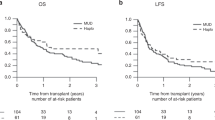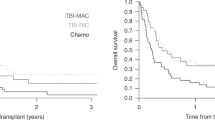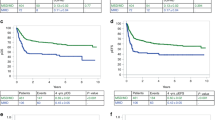Summary:
The role of allogeneic bone marrow transplantation (alloBMT) in adults with acute lymphoblastic leukemia (ALL) in first complete remission (CR1) remains controversial. At our institution, the policy is to offer alloBMT to ALL patients in CR1 up to the age of 55 years if a related donor is available. In addition, unrelated donor transplants are offered to patients with Philadelphia (Ph+) ALL. We report the results on 92 patients with ALL treated according to this policy from September 1992 to October 2001. Of the 87 patients achieving CR1, the comparison of patients with (n=48) or without donors (n=39) was done using an intention-to-treat approach. Of the 48 patients with donors (39 related and nine unrelated), 35 (73%) received alloBMT in CR1. No significant difference in 3-year event-free survival (EFS) (40 vs 39%, P=0.74) or overall survival (OS) (46 vs 58%, P=0.41) was seen in ‘donor’ vs ‘no-donor’ groups. For Ph+ patients, 3-year EFS and OS in ‘donor’ group were 46 and 57%, respectively, none of the patients in ‘no-donor’ group survived beyond 3 years. With our treatment strategy, 3-year OS of Ph+ patients was equivalent to Ph-negative (Ph−) patients (51 vs 52%, P=0.77). In conclusion, our data show that the policy of performing alloBMT if a sibling donor is available has not resulted in better outcome in Ph− patients.
This is a preview of subscription content, access via your institution
Access options
Subscribe to this journal
Receive 12 print issues and online access
$259.00 per year
only $21.58 per issue
Buy this article
- Purchase on Springer Link
- Instant access to full article PDF
Prices may be subject to local taxes which are calculated during checkout





Similar content being viewed by others
References
Hoelzer D, Thiel E, Loffler H et al. Prognostic factors in a multicenter study for treatment of acute lymphoblastic leukemia in adults. Blood 1988; 71: 123–131.
Larson RA, Dodge RK, Burns CP et al. A five-drug remission induction regimen with intensive consolidation for adults with acute lymphoblastic leukemia: cancer and leukemia group B study 8811. Blood 1995; 85: 2025–2037.
Durrant IJ, Prentice HG, Richards SM . Intensification of treatment for adults with acute lymphoblastic leukaemia: results of UK Medical Research Council randomized trial UKALL XA. Medical Research Council Working Party on Leukaemia in Adults. Br J Haematol 1997; 99: 84–92.
Larson RA, Dodge RK, Linker CA et al. A randomized controlled trial of filgrastim during remission induction and consolidation chemotherapy for adults with acute lymphoblastic leukemia: CALGB study 9111. Blood 1998; 92: 1556–1564.
Ribera JM, Ortega JJ, Oriol A et al. Late intensification chemotherapy has not improved the results of intensive chemotherapy in adult acute lymphoblastic leukemia. Results of a prospective multicenter randomized trial (PETHEMA ALL-89). Spanish Society of Hematology. Haematologica 1998; 83: 222–230.
Thiebaut A, Vernant JP, Degos L et al. Adult acute lymphocytic leukemia study testing chemotherapy and autologous and allogeneic transplantation. A follow-up report of the French protocol LALA 87. Hematol Oncol Clin North Am 2000; 14: 1353–1366, x.
Kantarjian HM, O'Brien S, Smith TL et al. Results of treatment with hyper-CVAD, a dose-intensive regimen, in adult acute lymphocytic leukemia. J Clin Oncol 2000; 18: 547–561.
Linker C, Damon L, Ries C, Navarro W . Intensified and shortened cyclical chemotherapy for adult acute lymphoblastic leukemia. J Clin Oncol 2002; 20: 2464–2471.
Annino L, Vegna ML, Camera A et al. Treatment of adult acute lymphoblastic leukemia (ALL): long-term follow-up of the GIMEMA ALL 0288 randomized study. Blood 2002; 99: 863–871.
Horowitz MM, Messerer D, Hoelzer D et al. Chemotherapy compared with bone marrow transplantation for adults with acute lymphoblastic leukemia in first remission. Ann Intern Med 1991; 115: 13–18.
Zhang MJ, Hoelzer D, Horowitz MM et al. Long-term follow-up of adults with acute lymphoblastic leukemia in first remission treated with chemotherapy or bone marrow transplantation. The Acute Lymphoblastic Leukemia Working Committee. Ann Intern Med 1995; 123: 428–431.
Sebban C, Lepage E, Vernant JP et al. Allogeneic bone marrow transplantation in adult acute lymphoblastic leukemia in first complete remission: a comparative study. French Group of Therapy of Adult Acute Lymphoblastic Leukemia. J Clin Oncol 1994; 12: 2580–2587.
Oh H, Gale RP, Zhang MJ et al. Chemotherapy vs HLA-identical sibling bone marrow transplants for adults with acute lymphoblastic leukemia in first remission. Bone Marrow Transplant 1998; 22: 253–257.
Rowe JM, Richards SM, Burnett AK et al. Favorable results of allogeneic bone marrow transplantation (BMT) for adults with Philadelphia (Ph) – chromosome – negative acute lymphoblastic leukemia (ALL) in first complete remission (CR): results from the international ALL trial (MRC UKALL XII/ECOG E2993). Blood 2001; 98: 481 (Abstr. 2009).
Blume KG, Forman SJ, Snyder DS et al. Allogeneic bone marrow transplantation for acute lymphoblastic leukemia during first complete remission. Transplantation 1987; 43: 389–392.
Vernant JP, Marit G, Maraninchi D et al. Allogeneic bone marrow transplantation in adults with acute lymphoblastic leukemia in first complete remission. J Clin Oncol 1988; 6: 227–231.
Gale RP, Park RE, Dubois RW et al. Delphi-panel analysis of appropriateness of high-dose therapy and bone marrow transplants in adults with acute lymphoblastic leukemia in first remission. Leuk Res 1998; 22: 973–981.
Catovsky D, Matutes E, Buccheri V et al. A classification of acute leukaemia for the 1990 s. Ann Hematol 1991; 62: 16–21.
Bennett JM, Catovsky D, Daniel MT et al. The morphological classification of acute lymphoblastic leukaemia: concordance among observers and clinical correlations. Br J Haematol 1981; 47: 553–561.
Ludwig WD, Raghavachar A, Thiel E . Immunophenotypic classification of acute lymphoblastic leukaemia. Baillieres Clin Haematol 1994; 7: 235–262.
Faderl S, Kantarjian HM, Talpaz M, Estrov Z . Clinical significance of cytogenetic abnormalities in adult acute lymphoblastic leukemia. Blood 1998; 91: 3995–4019.
Wetzler M, Dodge RK, Mrozek K et al. Prospective karyotype analysis in adult acute lymphoblastic leukemia: the cancer and leukemia Group B experience. Blood 1999; 93: 3983–3993.
Storb R, Deeg HJ, Whitehead J et al. Methotrexate and cyclosporine compared with cyclosporine alone for prophylaxis of acute graft versus host disease after marrow transplantation for leukemia. N Engl J Med 1986; 314: 729–735.
Ludwig WD, Rieder H, Bartram CR et al. Immunophenotypic and genotypic features, clinical characteristics, and treatment outcome of adult pro-B acute lymphoblastic leukemia: results of the German multicenter trials GMALL 03/87 and 04/89. Blood 1998; 92: 1898–1909.
Hoelzer D, Arnold R, Buechner T et al. Characteristics, outcome and risk factors in adult T-lineage acute lymphoblastic leukemia (ALL). Blood 1999; 94: 659a.
Gokbuget N, Hoelzer D, Arnold R et al. Treatment of Adult ALL according to protocols of the German Multicenter Study Group for Adult ALL (GMALL). Hematol Oncol Clin North Am 2000; 14: 1307–1325, ix.
Kaplan E, Meier P . Nonparametric estimation from incomplete observations. J Am Stat Assoc 1958; 53: 457–481.
Gooley TA, Leisenring W, Crowley J, Storer BE . Estimation of failure probabilities in the presence of competing risks: new representations of old estimators. Stat Med 1999; 18: 695–706.
Gray R, Wheatley K . How to avoid bias when comparing bone marrow transplantation with chemotherapy. Bone Marrow Transplant 1991; 7 (Suppl 3): 9–12.
Newell DJ . Intention-to-treat analysis: implications for quantitative and qualitative research. Int J Epidemiol 1992; 21: 837–841.
Barrett AJ, Horowitz MM, Ash RC et al. Bone marrow transplantation for Philadelphia chromosome-positive acute lymphoblastic leukemia. Blood 1992; 79: 3067–3070.
Dombret H, Gabert J, Boiron JM et al. Outcome of treatment in adults with Philadelphia chromosome-positive acute lymphoblastic leukemia-results of the prospective multicenter LALA-94 trial. Blood 2002; 100: 2357–2366.
Ottmann OG, Druker BJ, Sawyers CL et al. A phase 2 study of imatinib in patients with relapsed or refractory Philadelphia chromosome-positive acute lymphoid leukemias. Blood 2002; 100: 1965–1971.
Druker BJ, Sawyers CL, Kantarjian H et al. Activity of a specific inhibitor of the BCR-ABL tyrosine kinase in the blast crisis of chronic myeloid leukemia and acute lymphoblastic leukemia with the Philadelphia chromosome. N Engl J Med 2001; 344: 1038–1042.
Thomas D, Cortes J, Giles F et al. Combination of hyper-CVAD with imatinib mesylate (STI 571) for Philadephia (Ph)-positive adult acute lymphoblastic leukemia (ALL) or chronic myelogenous leukemia in lymphoid blast phase (CML-LBP). Blood 2001; 98: 803 (Abstr. 3340).
Acknowledgements
We thank Dawn Gilmour and Natasha Kotchetkova in the Leukemia and BMT registries for their assistance with data collection. We also thank the inpatient and outpatient nursing staff of Leukemia and BMT service for the excellent care provided to the patients.
Author information
Authors and Affiliations
Corresponding author
Rights and permissions
About this article
Cite this article
Gupta, V., Yi, QL., Brandwein, J. et al. The role of allogeneic bone marrow transplantation in adult patients below the age of 55 years with acute lymphoblastic leukemia in first complete remission: a donor vs no donor comparison. Bone Marrow Transplant 33, 397–404 (2004). https://doi.org/10.1038/sj.bmt.1704368
Received:
Accepted:
Published:
Issue Date:
DOI: https://doi.org/10.1038/sj.bmt.1704368
Keywords
This article is cited by
-
Impact of intensity of conditioning therapy in patients aged 40–60 years with AML/myelodysplastic syndrome undergoing allogeneic transplantation
Bone Marrow Transplantation (2011)
-
Treatment of Acute Lymphoblastic Leukemia in Adolescents and Young Adults
Current Oncology Reports (2011)
-
Long-term outcomes in adult patients below the age of 55 years with acute lymphoblastic leukemia treated with chemotherapy or allogeneic BM transplant in first CR
Bone Marrow Transplantation (2010)
-
Unrelated donor allogeneic transplantation for adult acute lymphoblastic leukemia: a review
Bone Marrow Transplantation (2008)
-
Allogeneic hematopoietic cell transplantation for adults with ALL
Bone Marrow Transplantation (2008)



